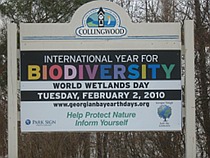International Year for Biodiversity is 2010
“We stand at a critical moment in Earth’s history, a time when humanity must choose its future. As the world becomes increasingly interdependent and fragile, the future at once holds great peril and great promise.” The Earth Charter
 Charles Darwin’s 200th birthday celebrations are coming to an end after an amazing year of scholarship and activities that have given us a better understanding of the man and his legacy. His many books have inspired many of us to want to protect biodiversity. (Biodiversity is often described as the diversity of life on Earth.) “On the Origin of Species” is inherently much more than the theory of evolution; it is a celebration of the interdependency of all life. Darwin’s 1831-36 voyage on the H.M.S. Beagle took him around the world. His “Voyage of the Beagle” jubilantly speaks of an Earth brimming with more life than our planet has ever known. By all scientific accounts we are losing that natural wealth created over millions of years at a faster rate than ever before.
Charles Darwin’s 200th birthday celebrations are coming to an end after an amazing year of scholarship and activities that have given us a better understanding of the man and his legacy. His many books have inspired many of us to want to protect biodiversity. (Biodiversity is often described as the diversity of life on Earth.) “On the Origin of Species” is inherently much more than the theory of evolution; it is a celebration of the interdependency of all life. Darwin’s 1831-36 voyage on the H.M.S. Beagle took him around the world. His “Voyage of the Beagle” jubilantly speaks of an Earth brimming with more life than our planet has ever known. By all scientific accounts we are losing that natural wealth created over millions of years at a faster rate than ever before.
The World Wildlife Fund Living Planet Report 2006, the International Union for the Conservation of Nature’s ‘Red List’ of threatened species or the United Nations’ Millennium Ecosystem Assessment’s ‘Ecosystems and Human Well-Being Biodiversity Synthesis’ will enable you to understand the depth of the biodiversity crisis. As well, the Convention on Biodiversity that was signed by Canada says,” The global biodiversity target will not be reached by 2010” in time for International Year of Biodiversity. In fact, continuing habitat loss, climate change, invasive alien species, pollution, human overpopulation, and over exploitation makes any target implausible if business-as-unusual prevails. Instead of now suggesting that a 2020 or a 2050 target be considered, many scientists want the Millennium Development Goals for 2015 be the inspiration for a concerted effort to bring down the rate of biological loss. New research entitled “The velocity of climate change” published in the science journal, Nature, describes the plight of species in keeping up with moving climates. The researchers estimated that, of the protected areas such as national parks that provide habitat for species, only 8 % would have a similar climate as they have now beyond the next 100 years. Therefore, unless we drastically lower greenhouse emissions and substantially enlarge protected areas, species will have nowhere to go when they are forced to migrate to a more hospitable climate. Humans must be included in the climate migration patterns.
No one knows how many species live on our planet. What are we prepared to do if the Earth is to continue to be home to five to thirty million species? The Earth Charter, developed as a result of the 1992 Earth Summit, is a way forward. Over the last several years, many communities have embraced the Earth Charter’s path on overcoming our greatest problems through “Respect and care for the community of life, Ecological Integrity, Social and economic justice, and Democracy, nonviolence and peace”.
Throughout the world new initiatives are taking hold to ‘take back’ the Earth. The Transition Initiative movement is based on moving from oil dependency/climate change to local resilience. It is making great headway in creating a new ethos away from planetary crisis to sustainability. www.transitiontowns.org and www.transitionculture.org
On January 16, it was encouraging to see so many young people attend the University of Guelph’s 16th Environmental Sciences Symposium. The Symposium made it clear that individuals and small groups of dedicated people do make a difference. We can all make International Year for Biodiversity a turning point for our planet through education and behavioural change that leads us towards a new era of respect for the Earth.
On January 25 at 1PM in Thornbury I will be giving a presentation on climate change and biodiversity at the Beaver Valley Community Centre as part of the Town of Blue Mountains’ lecture series. Please join us.

